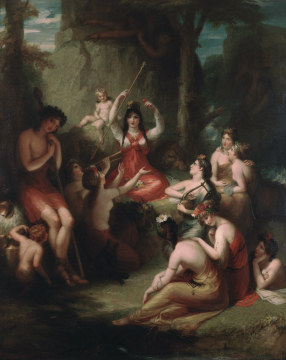Explore Collections


You are here:
CollectionsOnline
/
Comus listening to the Incantations of Circe
Browse
SM P48. ©Sir John Soane's Museum, London. Photo: Art UK
Henry Howard RA (1769 - 1847)
Comus listening to the Incantations of Circe
1831
Oil on canvas
Height: 127cm
Width: 101cm
Width: 101cm
Inscription: None
Museum number: P48
Not on display
Curatorial note
This painting illustrates a passage from John Milton's A Masque Presented at Ludlow Castle, 1634 ..., colloquially known as Comus, first performed at Ludlow Castle in 1634 for the 1st Earl of Bridgewater, and subsequently published in 1637. Milton later included the work in his Poems of 1645 and 1673: Soane owned a copy of the 1683 edition along with other volumes of Milton's poetry, some of which had belonged to the celebrated actor John Philip Kemble.
In Milton's poem the debauched Comus, a character inspired by the Greek God of revelry, encounters The Lady, the unnamed heroine of the masque, who has become separated from her brothers and is lost in the woods. Comus imprisons her and tries to force her to drink a magic potion that will place her in his power. She resists, urging the power of reason and the virtues of temperance and chastity. Meanwhile, her brothers encounter an angelic Attendant Spirit, who leads them to her and shows them how to defeat Comus. A song conjures a water spirit, Sabrina, who frees the virtuous Lady to return home with her brothers.
On first seeing The Lady, Comus soliloquizes on the 'divine ravishment' her appearance causes him. He conjures up the memory of his mother, the Goddess Circe, renowned for her knowledge of potions and herbs. He imagines her as shown here, sitting with three Sirens (in Greek mythology females who bind and imprison men with their magical singing), one playing a lyre and another the pipes, and Naiads (water nymphs). Their song lulls a prisoner into a charmed sleep (is he the youthful Shepherd on the left?) and subdues the fearsome Scylla and Charybdis, the legendary monsters who live on either side of a narrow channel of water (shown in the background). Howard's picture makes reference to the characterisation of Circe in Greek myths in which she is able to transform men into lions (a docile lion appears in the painting), wolves or swine (most famously Odysseus' men in Homer's Odyssey).
In Milton's poem the debauched Comus, a character inspired by the Greek God of revelry, encounters The Lady, the unnamed heroine of the masque, who has become separated from her brothers and is lost in the woods. Comus imprisons her and tries to force her to drink a magic potion that will place her in his power. She resists, urging the power of reason and the virtues of temperance and chastity. Meanwhile, her brothers encounter an angelic Attendant Spirit, who leads them to her and shows them how to defeat Comus. A song conjures a water spirit, Sabrina, who frees the virtuous Lady to return home with her brothers.
On first seeing The Lady, Comus soliloquizes on the 'divine ravishment' her appearance causes him. He conjures up the memory of his mother, the Goddess Circe, renowned for her knowledge of potions and herbs. He imagines her as shown here, sitting with three Sirens (in Greek mythology females who bind and imprison men with their magical singing), one playing a lyre and another the pipes, and Naiads (water nymphs). Their song lulls a prisoner into a charmed sleep (is he the youthful Shepherd on the left?) and subdues the fearsome Scylla and Charybdis, the legendary monsters who live on either side of a narrow channel of water (shown in the background). Howard's picture makes reference to the characterisation of Circe in Greek myths in which she is able to transform men into lions (a docile lion appears in the painting), wolves or swine (most famously Odysseus' men in Homer's Odyssey).
Soane paid Howard £300 for the painting on 24 January 1831. On 6 January he had written to Soane 'If you are in this quarter any day after one [o'clock] I shall be happy to shew you what I am doing ...'. On July 20 Howard wrote to Soane 'I at length send home your Circe, and hope that you will not find it discreditable to your collection'.
Literature
The London Literary Gazette, 14 May 1831, p.315
Soane, Description, 1835, pp. 16 and 23
Howard, F., Memoir…., 1848, p. lxxiv
Thornton and Dorey, A Miscellany of objects from Sir John Soane's Museum, 1992, p.124
Soane, Description, 1835, pp. 16 and 23
Howard, F., Memoir…., 1848, p. lxxiv
Thornton and Dorey, A Miscellany of objects from Sir John Soane's Museum, 1992, p.124
Exhibition history
Royal Academy of Arts, London, 1831
Soane collections online is being continually updated. If you wish to find out more or if you have any further information about this object please contact us: worksofart@soane.org.uk


